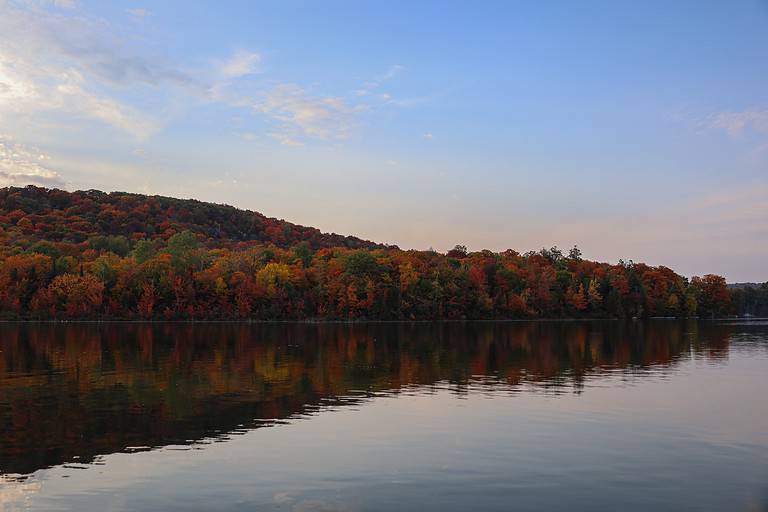Guide to Lake Erie’s Fishing Seasons

You’ve got bigger fish to fry than figuring out when to cast your line in Lake Erie. That’s why we’ve done the legwork for you.
In this ultimate guide, you’ll learn about the best fishing seasons for the lake’s most popular species. We’ll break down when and where to find Walleye, Perch, Smallmouth Bass, and Steelhead Trout.
So grab your gear; it’s time to reel in the big one!
Table of Contents
Key Takeaways
- The best fishing months for Walleye in Lake Erie, Ohio, are typically from late March to November, with peak times varying depending on water temperature and food availability.
- Walleye are most active during dawn and dusk, and slightly overcast days can be ideal for fishing them.
- Yellow Perch fishing is most opportune in late summer to early fall, particularly from August to October. They are most active during dawn and dusk, and their fishing depth should be adjusted according to the season.
- Smallmouth Bass have seasonal movements, with spring being the time to fish near the shore where they spawn, post-spawn finding them in transitional zones, summer leading to deeper waters for cooler temperatures, and fall bringing them back to shallow waters as the temperature cools. Understanding these movements can increase fishing success.
Identifying Lake Erie Fish Species
Often, you’ll encounter a diverse range of fish species in Lake Erie, and it’s crucial to know how to identify them accurately. Your success as an angler hinges on this knowledge. You see, each species has unique behaviors, habitats, and seasonal patterns that influence when, where, and how you can catch them.
Take the Walleye, for instance, one of the lake’s most prized species. They’re characterized by their olive-green color, large, glassy eyes, and sharp teeth. Walleyes are most active during low-light conditions, especially at dawn and dusk. They prefer deep, cold waters during the summer but move into shallower regions as temperatures drop in the autumn.
On the other hand, Yellow Perch, another popular catch, has bright yellow-green bodies with distinct dark stripes. They’re found in warmer, shallower waters near the shore and are most active during the day.
Lastly, there’s the smallmouth bass, known for its brown-green body and large, robust mouth. This species thrives in rocky areas and exhibits heightened activity during warmer months.
Peak Fishing Seasons for Walleye
You’ll find that the best months to catch Walleye in Lake Erie are typically from late March to November. It’s during this time that Walleye are most active, providing the best opportunities for a successful fishing trip. However, it’s worth noting that the specific peak times can vary slightly from year to year, depending on factors such as water temperature and food availability.
To increase your chances of catching Walleye, it’s essential to consider:
- Time of Day: Walleye are usually most active during dawn and dusk.
- Weather Conditions: Slightly overcast days can often be ideal for Walleye fishing.
- Location: Walleye tend to stay in deeper water during the day and move closer to shore at night.
- Bait Choices: Minnows, nightcrawlers, and leeches are among the most effective baits for Walleye.
Analyzing these factors and adjusting your fishing strategies accordingly can greatly enhance your Walleye fishing experience in Lake Erie. Remember, the key to successful fishing is patience and persistence, but understanding the fish’s behavior and optimal fishing conditions will undoubtedly give you an edge.
Optimal Perch Fishing Times
Just as with Walleye, there are certain times that you’re more likely to hook a Perch in Lake Erie. The most opportune time for perch fishing is late summer to early fall, particularly from August to October. During these months, the water temperature is ideal, stimulating the perch to feed more and thus increasing your chances of a successful catch.
However, time of day is also a crucial factor. Perch are typically most active during dawn and dusk. This is when they feed the most, so you’ll want to plan your fishing trips around these hours.
It’s important to consider the depth of the water too. Yellow perch, the species found in Lake Erie, are usually found in shallow waters during the spring and move to deeper waters as summer progresses. They return to the shallows in the fall. So adjust your fishing depth according to the season.
Seasonal Movements of Smallmouth Bass
In addition to Perch, another popular catch in Lake Erie is the Smallmouth Bass, and understanding their seasonal movements can significantly boost your fishing success. These fish are known for their distinctive behavior patterns, which change throughout the year.
During the spring, as the water warms, they move closer to the shore to spawn, providing an optimal opportunity for near-shore fishing. Post-spawn, they retreat to deeper waters for the summer, favoring cooler temperatures.
To maximize your catch, keep in mind these key points:
- Early season (spring): Fish near the shore where they spawn.
- Post-spawn (late spring to early summer): Look for them in transitional zones as they move to deeper waters.
- Summer: Try deeper waters where they seek cooler temperatures.
- Fall: They move back to shallow waters as the temperature cools.
Understanding these movements can make your fishing trips more fruitful.
Best Times for Steelhead Trout Fishing
Switching your focus to Steelhead Trout, you’ll find that timing is equally crucial for a successful catch. These migratory fish, a variety of rainbow trout, are renowned for their ability to put up a fight, making them a popular catch for anglers.
Steelhead Trout are typically in Lake Erie during two main periods. The first is late summer and early fall, around August to October. They’re preparing for spawning and are feeding heavily, increasing your chance of catching one.
The second peak is during spring, particularly from March to early May. This is post-spawn, when they’re returning to the lake. Fishing during these periods can be highly productive, but you’ll need to adapt your techniques. For instance, in the warmer months, you’ll find them in deeper, cooler waters.
Knowing the right time isn’t enough, though. You’ll need to monitor the weather conditions as well. Steelhead Trout fishing is best after a heavy rain when the river levels rise and the water gets cloudy. These conditions encourage the trout to move, making them easier to catch.
Frequently Asked Questions
What Types of Fishing Equipment Are Recommended for Fishing in Lake Erie, Ohio?
You’ll need sturdy rods, sharp hooks, and a reliable tackle box for Lake Erie fishing. Don’t forget your fishing license, and consider sonar equipment to locate fish in deeper waters. It’s all about preparation!
Are There Any Specific Fishing Regulations or Limits to Be Aware of in Lake Erie, Ohio?
Yes, you’ll need to mind certain “rules of the rod” in Lake Erie, Ohio. Regulations vary by species but generally include daily bag limits, minimum size requirements, and specific seasons for fishing certain fish.
Can I Fish at Any Time of the Day in Lake Erie, Ohio, or Are There Specific Hours?
Yes, you can fish at any time in Lake Erie, Ohio. However, it’s crucial to respect local regulations. Some areas might have specific hours due to safety or conservation reasons. Always check before heading out.
Are There Any Safety Precautions to Keep in Mind While Fishing in Lake Erie, Ohio?
Absolutely. Safety’s crucial while fishing in Lake Erie, Ohio. Always check local weather conditions, wear a life jacket, don’t fish alone, and ensure you’re aware of the lake’s unique characteristics, like sudden waves and currents.
Are There Guided Fishing Tours Available for Beginners in Lake Erie, Ohio?
Yes, you’re in luck! Lake Erie, Ohio, offers guided fishing tours for beginners. You don’t just learn to fish; you also get insights on the best fishing spots and seasons. It’s quite the catch!
Conclusion
So, you’ve got your tackle box ready, and you’re itching to cast your line into Lake Erie, Ohio. Remember, time your trips for walleye in spring and fall, perch in late summer, smallmouth bass in summer, and steelhead trout in winter.
Knowing when these fish species are most active gives you the edge. Now, all you need to do is reel them in.
Good luck, and here’s to a bountiful fishing season in Lake Erie, Ohio!






